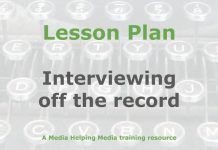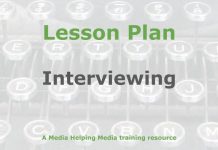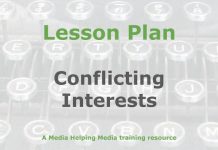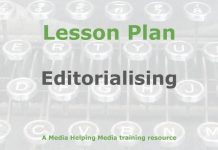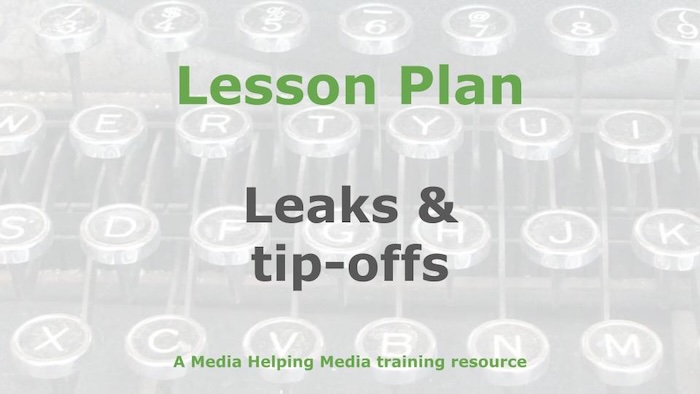 This one-day lesson plan is designed to teach students how to deal with story leaks and tip-offs. It’s free for journalism trainers to download and adapt for their own purposes.
This one-day lesson plan is designed to teach students how to deal with story leaks and tip-offs. It’s free for journalism trainers to download and adapt for their own purposes.
The lesson outline is based on the article Handling story leaks and tip-offs by Nicholas Jones, which we suggest you circulate for participants to read before attending the session.
09:00 – 09:30: Introduction: The critical factor: questioning the leaker’s motives
Course objective: To equip journalists with the essential critical judgement, ethical framework, and practical security protocols necessary to analyse, verify, and responsibly publish information obtained via leaks and anonymous tip-offs, while protecting their sources and mitigating legal and professional risks.
Participants will learn to:
- Differentiate motives: Distinguish between a principled whistleblower acting in the public interest and a calculated leak from a political or commercial spin doctor attempting to manipulate the media.
- Mitigate risk: Develop secure newsroom protocols to protect the anonymity of confidential sources, drawing lessons from high-profile legal precedents.
- Apply the public interest test: Scrupulously vet leaked material for veracity and determine if the public benefit of publication outweighs the potential harm, particularly concerning national security or personal privacy.
- Resource: ‘Journalism and the public interest‘.
- Avoid manipulation: Recognise the signs of a “planted story” and manage the pressure for an exclusive without compromising journalistic integrity.
- Resource: ‘Is your journalism being manipulated?’
- Resource: ‘Integrity and journalism’.
A journalist receiving a leak or tip-off experiences a rush of excitement – the potential for an exclusive, headline-making story is clear. However, the most critical factor in handling this material is analysing the motive of the leaker.
- Genuine leakers (whistleblowers): These are individuals taking an enormous personal risk (often their livelihood or liberty) because they believe the public is being misled. They are driven by a public interest principle.
- Calculated leaks (propaganda): This information is often supplied by political or commercial “spin doctors” who are adept at manipulating the news media. The leak is intended to secure timely, sympathetic coverage for a specific cause, faction, or to damage a rival.
- Objective: Participants will understand that they are always in danger of being used for political or malicious ends, and that the pressure to secure an exclusive must never supersede critical judgement.
09:30 – 10:30: Session 1: Identifying the agenda: how spin doctors use the press
Journalists must recognise the power of the exclusive story they secure, and the corresponding danger of being manipulated by those who provide it.
- Key concept: The ability of spin doctors to pick and choose the recipients of planted information, knowing that the pressure of the exclusive might encourage journalists to oblige.
- Activity 1: Deconstructing a planted story (60 minutes)
- Task: Participants are presented with two mock leaked documents: one clearly a politically targeted smear against a rival business leader, and the other a document revealing major public safety failings.
- Analysis: Working in small groups, participants analyse the language, timing, and potential source of each document.
- Discussion points: What is the political purpose? What questions must be asked before taking the story forward? How does the speed and spread of electronic leaks (email/social media) complicate this initial vetting?
10:30 – 10:45: Break
10:45 – 12:30: Session 2: The ethical and legal responsibilities of source protection
Journalists have a responsibility to protect sources who have put themselves in grave danger by exposing confidential information.
- Ethical duty: Self-respecting journalists are duty bound to protect the identity of sources, particularly those who have risked their careers for public benefit.
- Legal perils: Review of historical precedents, specifically the UK cases of Katherine Gun (whose prosecution was dropped) and Sarah Tisdall (who was imprisoned). Discussion of how legal pressures forced news outlets to compromise source protection.
- Procedural failure: The case of Sarah Tisdall, who was identified because the Guardian was ordered to surrender the document and “tell-tale marks” revealed the copying source.
- Activity 2: Drafting a source protection protocol (105 minutes)
- Task: Groups draft a newsroom protocol for handling sensitive physical and electronic leaks, based on the mistakes made in historic cases.
- Protocol considerations: Secure communication methods, immediate physical security of documents (such as shredding after details are printed), and procedures for resisting police or court orders to surrender material.
- Key takeaway: The journalist’s primary responsibility is to the source’s safety, which requires institutional rigour and preparation.
12:30 – 13:30: Lunch
13:30 – 15:00: Session 3: Responsible publication and risk management
Publication of leaked material must always balance public interest with national security and personal privacy.
- Vetting for risk: Care must always be taken to avoid revealing sensitive data, such as personal addresses, sensitive dates, timings, and locations that could endanger public figures or national security. Publication of such information can lead to prosecution.
- Resource: ‘Respecting privacy as a journalist’
- Resource: ‘Lesson : Respecting privacy as a journalist’
- Resource: ‘Privacy protection – scenario’
- Strategy shift: When precise details must not be disclosed, the emphasis can be switched to highlighting the fact that the leak itself – and the carelessness of those involved – represented a serious breach of security.
- Handling lost property: Journalists sometimes find sensitive documents lost in public places. The advice is to note the contents if they are useful, but always return them if there is an appropriate address, as there have been prosecutions for receiving or handling stolen property.
- Activity 3: The security breach dilemma (90 minutes)
- Scenario: Participants receive a confidential military document that reveals a major financial cover-up, but also contains the sensitive future travel itinerary of a senior diplomat.
- Decision-making: Groups should decide:
- Which parts of the document must be published and which must be withheld?
- How to verify the financial cover-up without compromising the diplomat’s security.
- What the headline should focus on (the cover-up or the security breach that allowed the information to be lost).
15:00 – 15:15: Break
15:15 – 16:30: Session 4: Reviewing historic cases and scenario planning
- This session is a deeper dive into the cases mentioned, followed by open discussion and application of the protocols developed in Activity 2 to various hypothetical leaks (such as medical data, commercial secrets, political strategy papers).
- The focus remains on applying the motive, veracity, and security matrix before any commitment to publish.
- A motive, veracity, and security (MVS) matrix is an informal but critical analytical framework used by journalists, particularly those handling investigative stories, leaks, and tip-offs, to decide whether and how to publish sensitive information. It’s a systematic way to assess the three most important ethical and practical questions surrounding confidential material:
- 1. Motive (Why was the information leaked?) This element assesses the source’s intent. If a journalist’s motive is simply to get a scoop, they risk being manipulated. The MVS matrix forces a shift to analysing the leaker’s goal.
- Assessment: Is the leaker a whistleblower acting on a genuine belief that the public interest outweighs their duty of confidentiality? Or are they a spin doctor or disgruntled party trying to damage a rival, settle a score, or advance a specific political/commercial agenda?
- Action: If the motive is purely malicious or self-serving, the journalist must proceed with extreme caution and ensure the final story serves the public, not the source. The motive helps determine editorial framing.
- 2. Veracity (Is the information true?) This is the fundamental journalistic test and must be completed regardless of the source’s motive. Leaked documents are often partial, outdated, or deliberately misleading.
-
- Assessment: Can the core facts in the leaked material be independently verified through corroborating sources, public records, or expert analysis? Is the document authentic? Is the source trustworthy on other, less sensitive matters?
- Action: If the veracity cannot be established, the material generally cannot be published. If only parts are verified, the publication must be limited strictly to those parts, noting the source.
- 3. Security (What are the risks of publishing?) This element assesses the consequences of publication on individuals, the public, and the news organisation itself, balancing public interest against genuine harm.
- Assessment: Does publishing the information pose a genuine threat to national security (such as revealing troop movements or intelligence assets)? Does it disclose sensitive personal data (e.g., home addresses, private medical records)? Does it put the source’s life or liberty in danger?
- Action: If a genuine and substantial security risk is identified, the journalist must redact or withhold the sensitive details. For instance, the story may shift to focusing on the fact of the security breach or the ethical wrongdoing, rather than disclosing the dangerous details. The story must pass the test of public interest outweighing public harm.
-
- 1. Motive (Why was the information leaked?) This element assesses the source’s intent. If a journalist’s motive is simply to get a scoop, they risk being manipulated. The MVS matrix forces a shift to analysing the leaker’s goal.
- A motive, veracity, and security (MVS) matrix is an informal but critical analytical framework used by journalists, particularly those handling investigative stories, leaks, and tip-offs, to decide whether and how to publish sensitive information. It’s a systematic way to assess the three most important ethical and practical questions surrounding confidential material:
The matrix ensures that before publication, the material has successfully passed scrutiny on its origin, its truthfulness, and its impact.
16:30 – 17:00: Conclusion and assignment
- Summary: We have covered the spectrum of leaks, from the principled whistleblower to the malicious spin doctor. The core task of the journalist is not just to report the information, but to analyse the reason the information was given, understand the massive legal and ethical risk to the source, and ensure that publication serves the public interest responsibly, without compromising security or exposing the leaker.
- Q&A and final discussion.
- Assignment: Analysing a modern leak
- Task: Select a major news story from the last year that was initiated by a leak (such as a data dump, a governmental tip-off, or a mislaid document).
- Report: Write a 500-word analysis (due in two weeks) addressing the following questions:
- What was the potential motive of the source? (Was it principled or calculated?)
- What evidence suggests the media outlet was being manipulated or used?
- How did the news organisation handle the source protection procedures (or what evidence suggests a failure of protocol)?
- Was the published story responsible, or did it risk national security or personal privacy unnecessarily?

